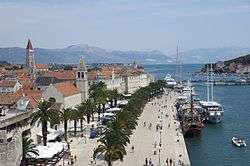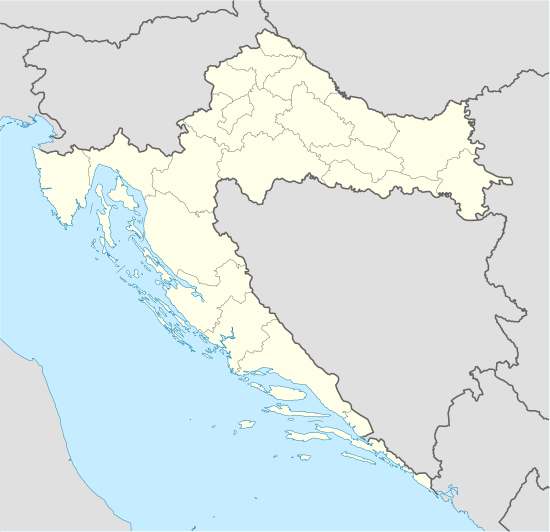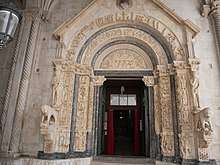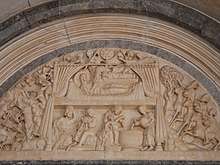Trogir
Trogir (Latin: Tragurium; Italian: Traù; Ancient Greek: Τραγύριον, Tragyrion or Τραγούριον, Tragourion)[1] is a historic town and harbour on the Adriatic coast in Split-Dalmatia County, Croatia, with a population of 10,818 (2011)[2] and a total municipal population of 13,260 (2011). The historic city of Trogir is situated on a small island between the Croatian mainland and the island of Čiovo.[3] It lies 27 kilometres (17 miles) west of the city of Split.
Trogir | |
|---|---|
| Grad Trogir Town of Trogir | |
 The Old Town of Trogir | |
 Flag  Seal | |
 Trogir Location of Trogir in Croatia | |
| Coordinates: 43°31′0.85″N 16°15′4.91″E | |
| Country | |
| County | |
| Government | |
| • Mayor | Ante Bilić (SDP) |
| Population (2011) | |
| • Total | 13,260 |
| Time zone | UTC+1 (CET) |
| • Summer (DST) | UTC+2 (CEST) |
| Postal code | 21220 |
| Area code(s) | 021 |
| Website | trogir.hr |


Since 1997, the historic centre of Trogir has been included in the UNESCO list of World Heritage Sites[4] for its Venetian architecture.
History
- For ecclesiastical history, see Roman Catholic Diocese of Tragurium
In the 3rd century BC, Tragurion was founded by Greek colonists[5] from the island of Vis, and it developed into a major port until the Roman period. The name comes from the Greek "tragos" (male goat). The name might also derive from the Illyrian word "Tregur" (Three Stones). Similarly, the name of the neighbouring island of Bua comes from the Greek "voua" (herd of cattle). The sudden prosperity of Salona deprived Trogir of its importance. During the migration of Croats the citizens of the destroyed Salona escaped to Trogir. Initially the Roman Tragurium was one of the Dalmatian City-States. From the 9th century on, Trogir paid tribute to Croatian rulers and to the Byzantine empire. The diocese of Trogir was established in the 11th century (abolished in 1828; it is now part of the Roman Catholic Archdiocese of Split-Makarska and has temporarily been a Latin titular bishopric) and in 1107 it was chartered by the king of Hungary, Croatia and Dalmatia Coloman, gaining thus its autonomy as a town.
In the year 1000 the Republic of Venice received submission from the Tragurium inhabitants and the city started since then to have commerce with the Italian peninsula enjoying cultural and economic improvements.
In 1123 Trogir was conquered and almost completely demolished by the Saracens. However, Trogir recovered in a short period to experience powerful economic prosperity in the 12th and the 13th centuries, with some autonomy under Venetian leadership. In 1242 King Béla IV of Hungary found refuge there as he fled the Mongols. In the 13th and the 14th centuries, members of the Šubić family were most frequently elected dukes by the citizens of Trogir; Mladen III (1348), according to the inscription on the sepulchral slab in the Cathedral of Trogir called "the shield of the Croats", was one of the most prominent Šubićs. In Dalmatian, the city was known as Tragur.
After the War of Chioggia between Genoa and Venice, on 14 March 1381 Chioggia concluded an alliance with Zadar and Trogir against Venice, and finally Chioggia became better protected by Venice in 1412, because Šibenik then became the seat of the main customs office and the seat of the salt consumers office with a monopoly on the salt trade in Chioggia and on the whole Adriatic Sea.
In 1420 the period of a long-term Venetian rule began and lasted nearly four centuries, when Trau (as the city was called by the Venetians) was one of the best cities in the Balkans with a rich economy and plenty of Renaissance works of art and architecture. In about 1650, a manuscript of the ancient Roman author Petronius' Satyricon was discovered in Trogir containing the 'Cena Trimalchionis' ('Dinner of Trimalchio') the longest surviving portion of the Satyricon, a major discovery for Roman literature.[6]
On the fall of Venice in 1797, Trogir became a part of the Habsburg Empire, which ruled over the city until 1918, with the exception of Napoleon Bonaparte's French rule from 1806 to 1814 (when the city was part of the Napoleonic Kingdom of Italy and Illyrian Provinces ).
After World War I, Trogir, together with most parts of Dalmatia, became a part of the State of Slovenes, Croats and Serbs and subsequently, the Kingdom of Yugoslavia. During this period Italian speakers, who until 1918 were the present in the city left for Italy. 1939 it become a part of Banovina of Croatia. During World War II, Trogir was annexed by Italy and was part of the Italian Governorate of Dalmatia from 1941- 1943. After short partisan rule it became part of Independent State of Croatia under German military supervision from 1943 - 44. Subsequently, Tito's Partisans liberated it in for second time 1944. After that it belonged to the second Yugoslavia, and since 1991 to Croatia.
Main sights
| UNESCO World Heritage Site | |
|---|---|
 | |
| Criteria | Cultural: ii, iv |
| Reference | 810 |
| Inscription | 1997 (21st session) |
| Area | 6.4 ha |
| Buffer zone | 4.8 ha |
Trogir has 2300 years of continuous urban tradition. Its culture was created under the influence of the ancient Greeks, and then the Romans, and Venetians. Trogir has a high concentration of palaces, churches, and towers, as well as a fortress on a small island, and in 1997 was inscribed in the UNESCO World Heritage List. "The orthogonal street plan of this island settlement dates back to the Hellenistic period and it was embellished by successive rulers with many fine public and domestic buildings and fortifications. Its beautiful Romanesque churches are complemented by the outstanding Renaissance and Baroque buildings from the Venetian period", says the UNESCO report.
Trogir is the best-preserved Romanesque-Gothic complex not only in the Adriatic, but in all of Central Europe. Trogir's medieval core, surrounded by walls, comprises a preserved castle and tower and a series of dwellings and palaces from the Romanesque, Gothic, Renaissance and Baroque periods. Trogir's grandest building is the church of St. Lawrence, whose main west portal is a masterpiece by Radovan, and the most significant work of the Romanesque-Gothic style in Croatia.
The most important sites include:
- Historical city core, with about 10 churches and numerous buildings from the 13th century
- The city gate (17th century) and city walls (15th century)
- The Fortress Kamerlengo (15th century)
- The Duke's Palace (13th century)
- The Cathedral (13th century) with the Portal of Master Radovan, the unique work of this Dalmatian artist
- The big and small palaces Cipiko from the 15th century
- The city loggia from 15th century
The St. Peter Church was part of the women's Benedictine monastery which was, according to the legend, founded by the wife of king Bela IV of Hungary. The west front of the church is embellished by a Baroque portal decorated with a bust of St. Peter, the work of Niccolo di Giovanni Fiorentino. The interior was restored in a Baroque style in the second half of the 17th century. The wooden ceiling dating from that period is divided into oval, semioval and hexagon fields, framed by richly decorated borders. It was then that the two side-altars were added, dedicated to Mother Mary and St. Ignatius of Loyola. The high altar from the same period was made of wood, but only the statues of St. Peter and St. Paul have survived to the present day. Set into the pavement of the church one finds tombs of Trogir noble families Andreis and Cipiko.
The St. Sebastian's Church was built in 1476 as a votive church or an offering given by the citizens of Trogir in thanks for deliverance from the plague. The front of this Renaissance building, which was executed by Niccolo di Giovanni Fiorentino, is decorated with the sculptures of St. Sebastian and Christ the Saviour. It displays the coats of arms of Bishop Giacomo Torlon and that of the duke Malipiero. Above the front rises the two-story tower of the town clock. A part of the eastern wall contains the remains of a centrally planned church with six apses dedicated to St. Mary. Against the west walls rests a plaque bearing names of the fallen defenders in the Croatian War for Independence.
The Town Loggia of Trogir was first recorded in documents of the 13th century. It served as a furnished public gathering space, and on certain dates and hours it was used by the communal legal service, as a place were contracts were signed, official announcements made, laws proclaimed, and where law proceedings took place. In 1471, the workshop of Niccolo di Giovanni Fiorentino executed a relief of Justice on the eastern wall, depicting the Venetian lion with S. Lawrence and B. John of Trogir, both guardians of the city. It was, in fact, a monument dedicated to the Republic of Venice. The central field with the lion was removed in 1932. On the south wall, the relief of a horseman depicting Petar Berislavić, viceroy of Croatia (1513–1520), was done by Ivan Meštrović. The Loggia was renovated in 1892.
The Garagnin-Fanfogna Palace is constituted of two blocks of Romanesque and Gothic buildings, incorporated into the ensemble in the second half of the 18th century, after the plans of Ignacije Macanović. The two-story building with the stone stairway situated on the south side originally had an economy purpose. Today its ground floor houses the town lapidarium within which the city walls of the Hellenistic Tragurion are presented. On the first floor there is Cata Dujšin-Ribar Gallery. The main entrance to the Palace with a lobby and a staircase was situated on the east side, in the main street, and decorated with a Late Baroque elements characteristic of the Macanović workshop. In the interior there is the original 18th century drawing room embellished with stucco decorations. The library owned by Ivan L. Garagnin (1722–1783), a numismatist and collector of archaeological monuments, is decorated with wall paintings portraying philosophers and writers. The ensemble houses collections of paintings and graphics from the 17th and 18th centuries and the Town Museum.
The Museum of sacred art is hosted in the Late Baroque building on the Trogir main square, dating from the 18th century. There is a rich collection of early Dalmatian and Venetian sacred paintings (14th–15th century) with masterpieces of Gentile Bellini, Paolo Veneziano, Quirizio da Murano and others. Works of local masters, paintings of Blaž Jurjev Trogiranin [Blase, son of George from Trogir] or the 13th century polyptych of the cathedral's high altar are exhibited in the Pinacotheca.
The Santa Maria de Platea belongs to the early 9th century hexafoil patern churches. It is the central type building, consisting of a high dome surrounded by six apses, in the manner of Carolingian chapels. In the 17th century visitation four altars were described: the high was dedicated to the Assumption of Mary; the Renaissance one, built in 1463 was dedicated to St. Jerome; the remaining two were dedicated to St. Mary of Loreto and St. Lucy respectively. The church was demolished in the mid 19th century, its only image is preserved on the 18th century French illustrator Ch. L. Clerisseau's drawing. The apses had three niches divided by pilaster strips on the outside surface wheres niches and windows gave rhythm to the tambour of the dome. To the west there was a portico used as a medieval courtroom, street was closed by the city clock tower in the 15th century.
Economy
Tourism is the most important economic factor in the Trogir region, covering 50% of the municipal budget with more than 20,000 beds in hotels and private apartments. It is one of the fastest growing ports for sail-tourism in Croatia, and boasts two yacht marinas. There is also a strong fishing and agriculture tradition among the population in surrounding areas.
The most important industry is shipbuilding, with shipyard "Trogir" established at the beginning of the 20th century. The shipyard has a capacity of two ships of 55,000 tons. Between 1990 and 2004, 93 ships were built in the shipyard.
Trogir has also been used as a location for several television productions; it notably featured in two 2010 episodes of the British TV series Doctor Who. Due to its Venetian architecture, it served as a double for 16th-century Venice in The Vampires of Venice, and as a double for 19th-century Provence in Vincent and the Doctor. It also doubled for 19th century Venice in the 2015 BBC miniseries Jonathan Strange & Mr Norrell,[7] and was used for scenes set in the city of Qarth in the HBO series Game of Thrones.[8]
Infrastructure
Trogir lies six kilometres (3.7 miles) from Split Airport, and a regular bus connects Trogir with the airport and Split. In the future, the Split Suburban Railway will be lengthened towards the airport and Trogir.
There are two yacht marinas in Trogir.
Water supply to Trogir is sourced from the Jadro River, the source that once supplied the ancient Diocletian's Palace.[9]
Sport in Trogir
- HNK Trogir (ex "Slaven") – football
- NK Trogir 1912 – football
- KK Trogir – basketball
- ŽRK Trogir – women's handball
- MRK Trogir – man's handball
Notable people from Trogir
- Johannes Lucius, historian
- Giovanni Dalmata, sculptor
- Petar Berislavić, Croatian ban
- Radovan, sculptor and architect
- Mila Schön, fashion designer, true name Maria Carmen Nutrizio
- Vinko Coce, singer and songwriter
Views

.

Climate
Climate in this area has mild differences between highs and lows, and there is adequate rainfall year-round. The Köppen Climate Classification subtype for this climate is "Csa" (Mediterranean climate/Mediterranean climate).
International relations
Twin towns – sister cities
Trogir is twinned with:
See also
- Dalmatia
- List of ancient cities in Illyria
- Dalmatian City-States
References
- Polybius (1839). "Polybii Historiarum reliquiae". google.gr. Retrieved 1 August 2015.
- Croatian Census 2001 (Popis stanovništva 2001)
- Frommer's Croatia by Karen Torme Olson & Sanja Bazulic Olson
- UNESCO World Heritage Centre. "Historic City of Trogir". unesco.org. Retrieved 1 August 2015.
- Footprint Croatia by Jane Foster
- Texts and Transmission "Petronius"
- "Jonathan Strange & Mr Norrell". Filming in Croatia. Retrieved 19 October 2016.
- "Top 6 Game of Thrones filming locations to visit by boat". boatinternational.com. Retrieved 19 October 2016.
- "Diocletian's Palace". The Megalithic Portal. Retrieved 1 August 2015.
- "МЕЖДУНАРОДНО СЪТРУДНИЧЕСТВО НА ОБЩИНА РУСЕ – Побратимени градове". Община Русе [Municipality Ruse] (in Bulgarian). Archived from the original on 2013-08-05. Retrieved 2013-08-12.
- "Újbuda története" [Újbuda – New in History, Twin Towns]. Rafia.hu (in Hungarian). Archived from the original on 2013-05-21. Retrieved 2013-08-11.
- "Partnerschaft mit Trogir e.V." partnerschaft-vaterstetten-trogir.de. Retrieved 1 August 2015.
External links
| Wikivoyage has a travel guide for Trogir. |
| Wikimedia Commons has media related to Trogir. |
.jpg)
